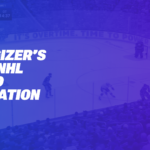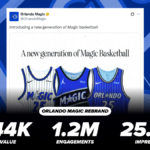
13 Jul The Stanley Cup on Social: Teams and Media Do Big Numbers For Finals
June is the month for league finals. While June brought us the the NBA and NHL Championships, for this report we’re analyzing key metrics for social media content surrounding the Stanley Cup. We will look at what accounts performed well during the playoffs and notable trends in the data.
Key metrics include social value, engagement rate, engagements, and impressions. Each of these metrics relate to one another to give a deeper analysis of the use of social overall social performance. Social value shows the calculated value of the post based on industry-standard CPM, CPE and CPV values. Engagements are calculated by the total number of interactions. Impressions are the number of times the content was seen. Engagement rate is engagements divided by impressions.
Tracking The Earned Media Conversation
When researching which accounts performed the best on social media during the Stanley Cup content was separated into earned and owned content. Earned content included anything that was not originally posted by the teams (Colorado Avalanche and Tampa Bay Lightning). For this report, we specifically tracked over 40 media accounts on Instagram and Twitter.
In total, external media accounts brought in 1,592 organic posts about the Stanley Cup, collecting over 233 million impressions, 1.65 million engagements and 23 million video views, overall earning a social value of $3,581,795. Top performing accounts were ESPN, Bleacher Report, and the NHL, likely because these accounts target the broader sports and hockey fan, which includes a multitude of demographics and a more diverse audience.
As for content that performed well, a post from ESPN on the first night of the playoffs brought in the most impressions. Though it doesn’t directly correlate to the teams that were playing in the finals, it shows different celebrities at NHL games over the season and is evidence of the overlap between sports and entertainment.
Game one had the highest metrics for earned media when compared to the rest of the series games, generating a social value of $955,000, 56.5 million impressions, and 697,729 engagements. Hype was big around the possibility of Tampa Bay winning their third consecutive Cup and the Avalanche continuing their dominating playoffs run.
As the series continued on, fans were stunned at the game two score of 7-0, a dominant win for Colorado. When filtering content from this game alone, it had the highest engagement rate from a specific account (the NHL) at 7.53% and totaled 1.09 million impressions. Additionally, this game came close to beating the league record for shutouts but came up short by one as the Penguins beat up on the Minnesota North Stars in Game 6 of the 1991 Stanley Cup Final 8-0.
Earned accounts didn’t always win out though, as shown in the winning social media posts from the top earned media account, ESPN, and the Colorado Avalanche, who won the series 4-2. Though ESPN has more followers and more engagement on a daily basis, their championship announcement post for the Avalanche did not perform as well as the content from the Avalanche. It makes sense that the Avalanche would fair better for this post, as fans were excited about the Avalanche bringing the cup back to Colorado for the first time in 21 years. Since followers of the Colorado Avalanche tend to be fans, their was a high follower interaction rate (11%), rise in engagements (69K+) and strong social value ($122K+).
THE 21-YEAR WAIT IS OVER!
— ESPN (@espn) June 27, 2022
The Colorado Avalanche are #StanleyCup champions for the third time in franchise history ⛰ pic.twitter.com/R0lSHeRkLu
YOUR 2022 STANLEY CUP CHAMPS#GOAVSGO pic.twitter.com/F9Y06SubCT
— Colorado Avalanche (@Avalanche) June 27, 2022
The Social Stanley Cup: Avalanche vs. Lightning
We can now compare the data from content put out right from the Tampa Bay Lightning and Colorado Avalanche themselves. Between the two teams’ Twitter and Instagram accounts there was $3.55 million dollars in social value and 869 organic posts over the course of the Stanley Cup Finals. Notably, this social value is similar to the value of the Stanley Cup content from the 40+ media accounts in the earned feed, but the owned feed only tracked two accounts. This shows that for a specific event, even one as big as the Stanley Cup Finals, individual teams create more engagement on their owned social media posts than those accounts that cover a wide range of sports.
Comparing the Avalanche and Lightning owned socials (Twitter and Instagram), here’s the data for each team:
Winning the Stanley Cup, it’s no surprise the Avalanche performed better across the board, but despite a tough series the Lightning still had virtually the same engagement rate and brought in millions of of impressions, engagements and social value dollars they wouldn’t have otherwise.
When looking at an example of game day posts from the Avalanche and the Lightning, in this case Game 4, the Lightning had a higher engagement and social value but the same engagement rate as the Avalanche. For this post specifically, factors like hometown advantage and the possibility to tie the series 2-2 could’ve swayed things in favor of Tampa. For any given day during a playoff series, teams have the opportunity to capitalize on these kinds of factors for high-performing social content.
Let's even this up. ⚡️#COLvsTBL: https://t.co/H47BTyMd9u pic.twitter.com/3mLoCV2nx6
— Tampa Bay Lightning (@TBLightning) June 22, 2022
Split the road.#FindAWay #GoAvsGo pic.twitter.com/vZqUFMWLGy
— Colorado Avalanche (@Avalanche) June 22, 2022
Though it was upsetting for Tampa fans that the Lightning did not win their third consecutive Cup, we can take a look back at their end of season post to show just how strong their fanbase is. This Instagram post brought in almost double the social value of a game day post and had one of the highest engagement rates of the season at 9.37%. Fans who interact and consistently show their love to a team, win or lose, have the most impact on team social media metrics and the overall value of the post.
Conclusion
Analyzing marquee events like the Stanley Cup Finals allow us see how playoffs impact social media metrics for teams and the media. The social data from the 2022 Stanley Cup finals provided some key insights:
- Winning brings in the most engagement and value, but strong fandom will not stop supporting on social media, even when a team doesn’t perform its best.
- The Lightning data showed how reaching the finals multiple years in a row builds up an engaged fanbase and impacts social performance.
- Although media coverage is important, team’s owned social accounts are the most impactful way to engage with fans.
For the future, this data can be used to compare to other six-game championship series as well as future Stanley Cup Playoffs. For now, we’ll let the Avalanche enjoy the win!









